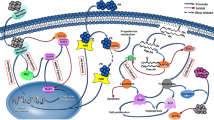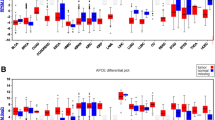Abstract
Background
To investigate the effects and mechanism of action of apolipoprotein M (ApoM) on the growth of breast cancer (BC) cells.
Methods and results
Bioinformatics, cell experiments and animal experiments were used to verify the effect of ApoM on breast cancer cell lines and breast tumor growth in vivo. ApoM expression was significantly reduced in BC tissues, and patients with lower ApoM mRNA expression had a poorer prognosis (P < 0.0001). Besides, ApoM can partially inhibit the proliferative, migratory and invasive processes of BC cells. In vivo, the difference between ApoM-OE and NC groups was no significant. The level of vitamin D receptor (VDR) protein in MDA-MB-231 cells was increased by overexpression of ApoM (P < 0.05), while in MCF-7 cells, VDR levels decreased (P < 0.05).
Conclusions
ApoM can partially inhibit the growth of BC cells. VDR may play a role, but is not the main pathway.




Similar content being viewed by others
Data availability
Not applicable.
Code availability
Not applicable.
References
IARC- Cancer Status. https://gco.iarc.fr/today/. Accessed 22 June 2021
Sorlie T, Perou CM, Tibshirani R, Aas T, Geisler S, Johnsen H, Hastie T, Eisen MB, van de Rijn M, Jeffrey SS, Thorsen T, Quist H, Matese JC, Brown PO, Botstein D, Lonning PE, Borresen-Dale AL (2001) Gene expression patterns of breast carcinomas distinguish tumor subclasses with clinical implications. Proc Natl Acad Sci U S A 98:10869–10874. https://doi.org/10.1073/pnas.191367098
Yin L, Duan JJ, Bian XW, Yu SC (2020) Triple-negative breast cancer molecular subtyping and treatment progress. Breast Cancer Res 22:61. https://doi.org/10.1186/s13058-020-01296-5
Wolff AC, Hammond MEH, Allison KH, Harvey BE, Mangu PB, Bartlett JMS, Bilous M, Ellis IO, Fitzgibbons P, Hanna W, Jenkins RB, Press MF, Spears PA, Vance GH, Viale G, McShane LM, Dowsett M (2018) Human epidermal growth factor receptor 2 testing in breast cancer: American society of clinical oncology/college of American pathologists clinical practice guideline focused update. J Clin Oncol 36:2105–2122. https://doi.org/10.1200/jco.2018.77.8738
Panet F, Couture F, Kwiatkowska A, Desjardins R, Guerin B, Day R (2017) PACE4 is an important driver of ZR-75-1 estrogen receptor-positive breast cancer proliferation and tumor progression. Eur J Cell Biol 96:469–475. https://doi.org/10.1016/j.ejcb.2017.03.006
Loibl S, Gianni L (2017) HER2-positive breast cancer. Lancet 389:2415–2429. https://doi.org/10.1016/S0140-6736(16)32417-5
Lea OA, Kvinnsland S, Thorsen T (1987) Progesterone-binding cyst protein in human breast tumor cytosol. Cancer Res 47:6189–6192
Zhou Y, Luo G (2020) Apolipoproteins, as the carrier proteins for lipids, are involved in the development of breast cancer. Clin Transl Oncol. https://doi.org/10.1007/s12094-020-02354-2
Liu Y-L, Zhang H-M, Pan H-M, Bao Y-H, Xue J, Wang T-C, Dong X-C, Li X-L, Bao H-G (2016) The relationship between apolipoprotein E gene epsilon 2/epsilon 3/epsilon 4 polymorphism and breast cancer risk: a systematic review and meta-analysis. Oncotargets Ther 9:1241–1249. https://doi.org/10.2147/ott.s94228
Song D, Yue L, Zhang J, Ma S, Zhao W, Guo F, Fan Y, Yang H, Liu Q, Zhang D, Xia Z, Qin P, Jia J, Yue M, Yu J, Zheng S, Yang F, Wang J (2016) Diagnostic and prognostic significance of serum apolipoprotein C-I in triple-negative breast cancer based on mass spectrometry. Cancer Biol Ther 17:635–647. https://doi.org/10.1080/15384047.2016.1156262
Xu N, Dahlback B (1999) A novel human apolipoprotein (apoM). J Biol Chem 274:31286–31290. https://doi.org/10.1074/jbc.274.44.31286
Croyal M, Billon-Crossouard S, Goulitquer S, Aguesse A, Leon L, Fall F, Chetiveaux M, Moyon T, Blanchard V, Ouguerram K, Lambert G, Nobecourt E, Krempf M (2018) Stable isotope kinetic study of ApoM (Apolipoprotein M). Arterioscler Thromb Vasc Biol 38:255–261. https://doi.org/10.1161/ATVBAHA.117.310208
Axler O, Ahnstrom J, Dahlback B (2007) An ELISA for apolipoprotein M reveals a strong correlation to total cholesterol in human plasma. J Lipid Res 48:1772–1780. https://doi.org/10.1194/jlr.M700113-JLR200
Zhu Y, Luo G, Jiang B, Yu M, Feng Y, Wang M, Xu N, Zhang X (2018) Apolipoprotein M promotes proliferation and invasion in non-small cell lung cancers via upregulating S1PR1 and activating the ERK1/2 and PI3K/AKT signaling pathways. Biochem Biophys Res Commun 501:520–526. https://doi.org/10.1016/j.bbrc.2018.05.029
Mu QF, Luo GH, Chen LJ, Wei J, Zheng L, Zhang XY, Xu N (2012) Apolipoprotein M expression in human colorectal cancer tissues and its clinicopathological relevance. Zhonghua Wei Chang Wai Ke Za Zhi 15:855–858
Xue H, Yu M, Zhou Y, Zhang J, Mu Q, Chen T, Luo G, Liu J (2020) Apolipoprotein M inhibits proliferation and migration of larynx carcinoma cells. Sci Rep 10:19424. https://doi.org/10.1038/s41598-020-76480-w
Bakke D, Sun J (2018) Ancient nuclear receptor VDR with new functions: microbiome and inflammation. Inflamm Bowel Dis 24:1149–1154. https://doi.org/10.1093/ibd/izy092
Huss L, Butt ST, Borgquist S, Elebro K, Sandsveden M, Rosendahl A, Manjer J (2019) Vitamin D receptor expression in invasive breast tumors and breast cancer survival. Breast Cancer Res 21:84. https://doi.org/10.1186/s13058-019-1169-1
Yu M, Pan L, Sang C, Mu Q, Zheng L, Luo G, Xu N (2019) Apolipoprotein M could inhibit growth and metastasis of SMMC7721 cells via vitamin D receptor signaling. Cancer Manage Res 11:3691–3701. https://doi.org/10.2147/CMAR.S202799
Yu M-M, Yao S, Luo K-M, Mu Q-F, Yu Y, Luo G-H, Xu N (2017) Apolipoprotein M increases the expression of vitamin D receptor mRNA in colorectal cancer cells detected with duplex fluorescence reverse transcription-quantitative polymerase chain reaction. Mol Med Rep 16:1167–1172. https://doi.org/10.3892/mmr.2017.6716
Györffy B, Lanczky A, Eklund AC, Denkert C, Budczies J, Li Q, Szallasi Z (2010) An online survival analysis tool to rapidly assess the effect of 22,277 genes on breast cancer prognosis using microarray data of 1809 patients. Breast Cancer Res Treat 123:725–731. https://doi.org/10.1007/s10549-009-0674-9
Schmittgen TD, Livak KJ (2008) Analyzing real-time PCR data by the comparative C(T) method. Nat Protoc 3:1101–1108. https://doi.org/10.1038/nprot.2008.73
Wolfrum C, Poy MN, Stoffel M (2005) Apolipoprotein M is required for prebeta-HDL formation and cholesterol efflux to HDL and protects against atherosclerosis. Nat Med 11:418–422. https://doi.org/10.1038/nm1211
Christoffersen C, Obinata H, Kumaraswamy SB, Galvani S, Ahnstrom J, Sevvana M, Egerer-Sieber C, Muller YA, Hla T, Nielsen LB, Dahlback B (2011) Endothelium-protective sphingosine-1-phosphate provided by HDL-associated apolipoprotein M. Proc Natl Acad Sci U S A 108:9613–9618. https://doi.org/10.1073/pnas.1103187108
Hajny S, Christoffersen C (2017) A novel perspective on the ApoM-S1P axis, highlighting the metabolism of ApoM and its role in liver fibrosis and neuroinflammation. Int J Mol Sci. https://doi.org/10.3390/ijms18081636
Zheng Z, Zeng Y, Zhu X, Tan Y, Li Y, Li Q, Yi G (2019) ApoM-S1P modulates Ox-LDL-induced inflammation through the PI3K/Akt signaling pathway in HUVECs. Inflammation 42:606–617. https://doi.org/10.1007/s10753-018-0918-0
Ding BS, Yang D, Swendeman SL, Christoffersen C, Nielsen LB, Friedman SL, Powell CA, Hla T, Cao Z (2020) Aging suppresses sphingosine-1-phosphate chaperone ApoM in circulation resulting in maladaptive organ repair. Dev Cell 53:677-690.e4. https://doi.org/10.1016/j.devcel.2020.05.024
Arkensteijn BW, Berbee JF, Rensen PC, Nielsen LB, Christoffersen C (2013) The apolipoprotein m-sphingosine-1-phosphate axis: biological relevance in lipoprotein metabolism, lipid disorders and atherosclerosis. Int J Mol Sci 14:4419–4431. https://doi.org/10.3390/ijms14034419
Aponte-Ubillus JJ, Barajas D, Peltier J, Bardliving C, Shamlou P, Gold D (2018) Molecular design for recombinant adeno-associated virus (rAAV) vector production. Appl Microbiol Biotechnol 102:1045–1054. https://doi.org/10.1007/s00253-017-8670-1
Feldman D, Krishnan AV, Swami S, Giovannucci E, Feldman BJ (2014) The role of vitamin D in reducing cancer risk and progression. Nat Rev Cancer 14:342–357. https://doi.org/10.1038/nrc3691
Funding
This work was supported by the Changzhou International Scientific and Technological Cooperation Project (Grant No. CZ20180018) and the Major Science and Technology Projects of Changzhou Health and Family Planning Commission (Grant No. ZD201803).
Author information
Authors and Affiliations
Contributions
GL, NX and MY contributed to the study conception and design. Material preparation, data collection and analysis were performed by YZ and SY. The first draft of the manuscript was written by YZ and all authors commented on previous versions of the manuscript. All authors read and approved the final manuscript.
Corresponding author
Ethics declarations
Conflict of interest
The authors have no relevant financial or non-financial interests to disclose.
Ethical approval
The experimental protocol was established, according to the ethical guidelines of the Helsinki Declaration and was approved by the Human Ethics Committee of the third affiliated hospital of Soochow University.
Consent to participate
Participants provided written informed consent before enrolment.
Consent for publication
Not applicable.
Additional information
Publisher's Note
Springer Nature remains neutral with regard to jurisdictional claims in published maps and institutional affiliations.
Supplementary Information
Below is the link to the electronic supplementary material.
Rights and permissions
About this article
Cite this article
Zhou, Y., Yao, S., Yu, M. et al. The effects and possible mechanism of action of apolipoprotein M on the growth of breast cancer cells. Mol Biol Rep 49, 1171–1179 (2022). https://doi.org/10.1007/s11033-021-06945-2
Received:
Accepted:
Published:
Issue Date:
DOI: https://doi.org/10.1007/s11033-021-06945-2




